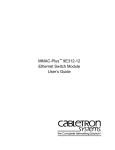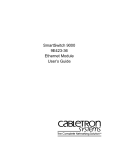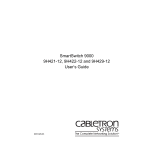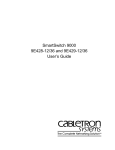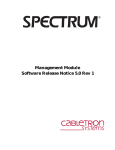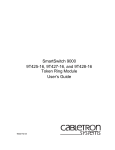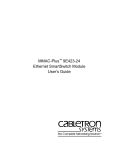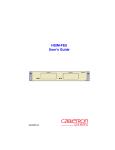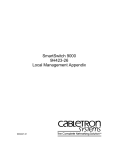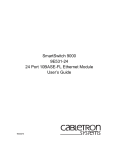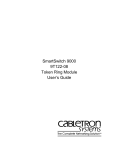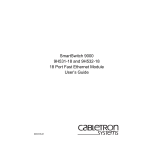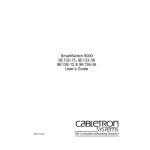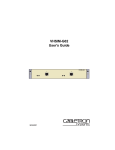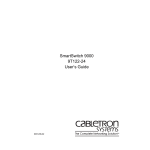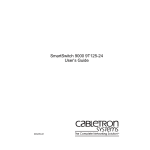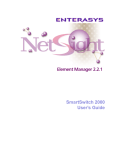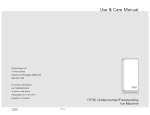Download Enterasys SmartSwitch 9000 Expansion Module
Transcript
SmartSwitch 9000 9H423-28 User’s Guide 9032061-01 Notice Notice Cabletron Systems reserves the right to make changes in specifications and other information contained in this document without prior notice. The reader should in all cases consult Cabletron Systems to determine whether any such changes have been made. The hardware, firmware, or software described in this manual is subject to change without notice. IN NO EVENT SHALL CABLETRON SYSTEMS BE LIABLE FOR ANY INCIDENTAL, INDIRECT, SPECIAL, OR CONSEQUENTIAL DAMAGES WHATSOEVER (INCLUDING BUT NOT LIMITED TO LOST PROFITS) ARISING OUT OF OR RELATED TO THIS MANUAL OR THE INFORMATION CONTAINED IN IT, EVEN IF CABLETRON SYSTEMS HAS BEEN ADVISED OF, KNOWN, OR SHOULD HAVE KNOWN, THE POSSIBILITY OF SUCH DAMAGES. © Copyright March 1998 by: Cabletron Systems, Inc. 35 Industrial Way Rochester, NH 03867-5005 All Rights Reserved Printed in the United States of America Order Number: 9032061-01 LANVIEW is a registered trademark, and SmartSwitch is a trademark of Cabletron Systems, Inc. CompuServe is a registered trademark of CompuServe, Inc. i960 microprocessor is a registered trademark of Intel Corp. Ethernet is a trademark of Xerox Corporation. i Notice FCC Notice This device complies with Part 15 of the FCC rules. Operation is subject to the following two conditions: (1) this device may not cause harmful interference, and (2) this device must accept any interference received, including interference that may cause undesired operation. NOTE: This equipment has been tested and found to comply with the limits for a Class A digital device, pursuant to Part 15 of the FCC rules. These limits are designed to provide reasonable protection against harmful interference when the equipment is operated in a commercial environment. This equipment uses, generates, and can radiate radio frequency energy and if not installed in accordance with the operator’s manual, may cause harmful interference to radio communications. Operation of this equipment in a residential area is likely to cause interference in which case the user will be required to correct the interference at his own expense. WARNING: Changes or modifications made to this device which are not expressly approved by the party responsible for compliance could void the user’s authority to operate the equipment. VCCI Notice This is a Class A product based on the standard of the Voluntary Control Council for Interference by Information Technology Equipment (VCCI). If this equipment is used in a domestic environment, radio disturbance may arise. When such trouble occurs, the user may be required to take corrective actions. DOC Notice This digital apparatus does not exceed the Class A limits for radio noise emissions from digital apparatus set out in the Radio Interference Regulations of the Canadian Department of Communications. Le présent appareil numérique n’émet pas de bruits radioélectriques dépassant les limites applicables aux appareils numériques de la class A prescrites dans le Règlement sur le brouillage radioélectrique édicté par le ministère des Communications du Canada. ii Notice DECLARATION OF CONFORMITY ADDENDUM Application of Council Directive(s): Manufacturer’s Name: Manufacturer’s Address: European Representative Name: European Representative Address: Conformance to Directive(s)/Product Standards: Equipment Type/Environment: 89/336/EEC 73/23/EEC Cabletron Systems, Inc. 35 Industrial Way PO Box 5005 Rochester, NH 03867 Mr. J. Solari Cabletron Systems Limited Nexus House, Newbury Business Park London Road, Newbury Berkshire RG13 2PZ, England EC Directive 89/336/EEC EC Directive 73/23/EEC EN 55022 EN 50082-1 EN 60950 Networking Equipment, for use in a Commercial or Light Industrial Environment. We the undersigned, hereby declare, under our sole responsibility, that the equipment packaged with this notice conforms to the above directives. Manufacturer Legal Representative in Europe Mr. Ronald Fotino ____________________________________________________ Full Name Mr. J. Solari ______________________________________________________ Principal Compliance Engineer ____________________________________________________ Title Managing Director - E.M.E.A. ______________________________________________________ Rochester, NH, USA ____________________________________________________ Location Newbury, Berkshire, England ______________________________________________________ Location Full Name Title iii Notice Safety Information CLASS 1 LASER TRANSCEIVERS The FPIM-05 and FPIM-07 are Class 1 Laser Products CLASS 1 LASER PRODUCT The FPIM-05 and FPIM-07 use Class 1 Laser transceivers. Read the following safety information before installing or operating these adapters. The Class 1 laser transceivers use an optical feedback loop to maintain Class 1 operation limits. This control loop eliminates the need for maintenance checks or adjustments. The output is factory set, and does not allow any user adjustment. Class 1 Laser transceivers comply with the following safety standards: • 21 CFR 1040.10 and 1040.11 U.S. Department of Health and Human Services (FDA). • IEC Publication 825 (International Electrotechnical Commission). • CENELEC EN 60825 (European Committee for Electrotechnical Standardization). When operating within their performance limitations, laser transceiver output meets the Class 1 accessible emission limit of all three standards. Class 1 levels of laser radiation are not considered hazardous. iv Notice Safety Information CLASS 1 LASER TRANSCEIVERS Laser Radiation and Connectors When the connector is in place, all laser radiation remains within the fiber. The maximum amount of radiant power exiting the fiber (under normal conditions) is -12.6 dBm or 55 x 10-6 watts. Removing the optical connector from the transceiver allows laser radiation to emit directly from the optical port. The maximum radiance from the optical port (under worst case conditions) is 0.8 W cm-2 or 8 x 103 W m2 sr-1. Do not use optical instruments to view the laser output. The use of optical instruments to view laser output increases eye hazard. When viewing the output optical port, power must be removed from the network adapter. v Notice vi Contents Chapter 1 Introduction Features........................................................................................................................... 1-2 Related Manuals............................................................................................................ 1-6 Getting Help .................................................................................................................. 1-6 Chapter 2 Installing the 9H423-28 Module Unpacking the Module................................................................................................. 2-1 Installing an FEPIM ...................................................................................................... 2-1 User Accessible Components ...................................................................................... 2-2 Setting the Module DIP Switch ................................................................................... 2-3 Installing the Module in the SmartSwitch 9000 Chassis ......................................... 2-5 The Reset Switch ........................................................................................................... 2-7 Chapter 3 Operation ENIB/FENIB.................................................................................................................. 3-2 SmartSwitch ASIC......................................................................................................... 3-3 Traditional Switch.................................................................................................. 3-3 VLAN.............................................................................................................................. 3-3 VLAN Domains...................................................................................................... 3-4 Fully-Meshed VLAN Domains ............................................................................ 3-5 SecureFast VLAN Switches ......................................................................................... 3-5 i960 Core......................................................................................................................... 3-6 INB NIB .......................................................................................................................... 3-6 System Management Buses ......................................................................................... 3-6 SMB-1 Bus ............................................................................................................... 3-6 SMB-10 Bus ............................................................................................................. 3-7 System Diagnostic Controller...................................................................................... 3-7 DC/DC Converter ........................................................................................................ 3-7 INB Interface.................................................................................................................. 3-7 ITDM Arbitration Levels ...................................................................................... 3-8 Monarch/Slave SmartSwitch 9000 Modules ..................................................... 3-9 Chapter 4 LANVIEW LEDs vii Contents Chapter 5 Specifications Technical Specifications ................................................................................................ 5-1 CPU .......................................................................................................................... 5-1 Memory ................................................................................................................... 5-1 Standards:................................................................................................................ 5-1 Network Interfaces ................................................................................................ 5-1 Safety............................................................................................................................... 5-2 Service ............................................................................................................................. 5-2 Physical ........................................................................................................................... 5-2 Dimensions ............................................................................................................. 5-2 Weight ...................................................................................................................... 5-2 Environment ........................................................................................................... 5-3 FE-100TX........................................................................................................................A-1 FE-100FX........................................................................................................................A-1 viii Chapter 1 Introduction The 9H423-28 (Figure 1-1) is a switching module with twenty-four 10 Mbps Ethernet ports and four 100 Mbs Fast Ethernet ports. The module is configured with two RJ21 connectors, two RJ45 connectors, two ST fiber connectors and a slot for an FEPIM. The two RJ21 connectors provide twenty-four 10 Mbps Ethernet ports. The RJ45 connectors, ST connectors and FEPIM (the module supports either the FE-100TX or the FE-100FX) provide the four 100 Mbps Ethernet ports. The two ST connectors represent a single port, as one connector is for transmit and one is for receive. Each module also provides an additional port that connects directly to the Internal Network Bus (INB) backplane interface. This module uses a SmartSwitch ASIC design and an advanced Intel i960® microprocessor. This microprocessor provides a platform for all management functions within a scalable RISC-Based Architecture. This module can operate in two modes: either as a 28-port Ethernet traditional switch (using 802.1d standards) with a high speed backbone connection, or as a Secure Fast Switch (SFS) with 28 Ethernet connections. Each port can be configured to operate in the Full Duplex mode. This configuration allows each 10BASE-T port to provide a full 20 Mbps of bandwidth and the 100BASE-T ports to provide 200 Mbps of bandwidth. The fiber ports on this module operate only in Full Duplex mode. Network management information is available through a variety of methods. All information based on Simple Network Management Protocol (SNMP) is accessible either via an in-band (Front Panel port), Side Band (SMB-10), or via the Environmental Module’s COM ports. Serial Line Internet Protocol (SLIP) or Point-to-Point Protocol (PPP) is supported by the Environmental Module’s COM ports. For more information on the SMB-10, SLIP, or PPP, refer to the SmartSwitch 9000 Local Management User’s Guide. The 9H423-28 also features front panel LANVIEW™ Diagnostic LED’s to offer ata-glance status information about each front panel port, as well as the operation of the overall module. 1-1 Introduction Features Processor The 9H423-28 module is equipped with an advanced Intel i960 microprocessor. This microprocessor provides a platform for all management functions, such as Spanning Tree, RMON, and MIB support, within a scalable RISC-Based architecture. Fast Packet Switching The 9H423-28 module incorporates a hardware-based switch design referred to as the SmartSwitch ASIC, a collection of custom ASICs designed specifically for high-speed switching. Because all frame translation, address lookups, and forwarding decisions are performed in hardware, these modules can obtain a throughput performance of greater than 750K pps. Management The 9H423-28 features SNMP for local and remote management. Local management is provided through the RS-232 COM ports on the SmartSwitch 9000 Environmental Module, using a standard VT-220 TM terminal or emulator. Remote management is possible through Cabletron’s SPECTRUM or any SNMPcompliant management tool. Included as management features are the IETF Standard Management Information Base (MIBs) RMON (RFC1271), IETF MIB II (RFC-1213), IETF Bridge MIB (RFC-1493), and a host of other Cabletron enterprise MIBs. These modules also offer a wide variety of statistical network management information to enhance network planning and troubleshooting. The 9H423-28 provides information for each front panel Ethernet port, including packet counts along with errored frame information, such as collisions, CRCs, and Giants, via a variety of industry standard and private MIBS. Industry-standard IEEE 802.1d bridging, including Spanning Tree Algorithm, is supported. Connectivity The 9H423-28 module has one interface to the INB and 28 front port connections. The INB interface is a fixed connection to INB-B that allows the module to communicate with other SmartSwitch 9000 modules supporting various LAN technologies including: Token Ring, FDDI, Ethernet, WAN, Fast Ethernet and ATM. The module is configured with two RJ21 connectors, two RJ45 connectors, two ST fiber connectors and a slot for an FEPIM. The two RJ21 connectors provide twenty-four 10 Mbps Ethernet ports, and the RJ45 connectors, ST connectors and FEPIM (the module supports either the FE-100TX or the FE-100FX) provide four 100 Mbps Ethernet ports. The multimode ST connectors provide a 100BASE-FL connection, with links up to 2000 meters in length. Auto-negotiation The auto-negotiation feature (available only with the 100BASE-T RJ45 ports ) allows the module to automatically use the fastest rate supported by the device at the other end (either 10 Mbps or 100 Mbps at either half or full duplex). To 1-2 Introduction negotiate duplex, both the 9H423-28 and the attached device must be configured for auto-negotiation. If only the 9H423-28 is configured for auto-negotiation, the module will set the connection to half duplex at either the 10 Mbps or 100 Mbps rate. This technology is similar to how modems negotiate transmission speed, finding the highest transmission rate possible. Similarly, auto-negotiation determines the highest common speed between two devices and communicates at that speed. If no common speed is detected, the device will be partitioned. NOTE All RJ45 connections are capable of auto-negotiation, and can operate at 10 Mbps or 100 Mbps, full or half duplex. Fiber connections can only operate at the 100 Mbps rate, full or half duplex. Standard Ethernet/Full Duplex Operation The 9H423-28 module supports both 100BASE and 10BASE technology. This allows each port on the module to be configured, through local and or remote management (SNMP), to operate in standard Ethernet mode (simplex) or full duplex mode. Operating in standard Ethernet mode limits bandwidth to 10 Mbps/100Mbps per port, while operating in duplex mode doubles bandwidth from 10 Mbps/100Mbps to 20 Mbps/200 Mbps per port. Management Information Base (MIB) Support The 9H423-28 module provides MIB support including: • • • RMON (RFC-1271) IETF MIB II (RFC-1213) IETF Bridge MIB (RFC-1493) and a host of other Cabletron Enterprise MIBs. NOTE For a complete list of supported MIBs, refer to the release notes provided with the 9H423-28. INB The 9H423-28 module attaches to INB-B of the SmartSwitch 9000 Backplane. The INB Backplane is designed to transport fixed length data blocks between modules in the SmartSwitch 9000 using an INB Time Division Multiplexing (ITDM) design. The SmartSwitch 9000 INB bus delivers 2.5 Gbps of true data bandwidth with all control and management communication being serviced on the 8-bit out-of-band bus. The time slices of the INB manager operates in all three modes at once, without user intervention. 1-3 Introduction Arbitration for the backplane is accomplished in the INB Time Division Multiplexing (ITDM) logic. The arbitration is a three-level scheme that ensures that no one can get the backplane for more than one time slice at a time. The ITDM RAM contains 256 4-bit locations. This RAM is used to hold slot numbers of modules participating in INB backplane arbitration. The arbitration engine accesses this RAM once every time slice to get a slot number. That slot number will be granted access on the next time slice if it is requesting. The arbitration engine is always one time slice ahead, meaning that the value read from the RAM is for the next time slice, not the current time slice. LANVIEW LEDs The 9H423-28 module uses LANVIEW – the Cabletron Systems built-in visual diagnostic and status monitoring system. With LANVIEW LEDs, you can quickly identify, at a glance, system status as well as the device, port, and physical layer status. Two LEDs indicate the transmission and reception of data from the INB SmartSwitch 9000 backplane connection. Each of the 12 Ethernet front panel ports features two LEDs per port to indicate the port’s Administrative status (enabled/ disabled), LINK status (Link/Nolink), and Data Activity (receiving and transmitting data). 1-4 Introduction FAST ENET 9H423-28 SMB CPU INB FAST ENET 28 27 26X 25X ETHERNET 24 10 B A S E T 13 12 10 B A S E T 1 Figure 1-1. The 9H423-28 Module 1-5 Introduction Related Manuals The manuals listed below should be used to supplement the procedures and technical data contained in this manual. SmartSwitch 9000 Installation Guide SmartSwitch 9000 9C300-1 Environmental Module User’s Guide SmartSwitch 9000 9C214-1 AC Power Supply User’s Guide SmartSwitch 9000 Local Management User’s Guide INB Terminator Modules Installation Guide Getting Help For additional support related to this device or document, contact the Cabletron Systems Global Call Center: Phone (603) 332-9400 Internet mail [email protected] FTP Login Password ctron.com (134.141.197.25) anonymous your email address Modem setting (603) 335-3358 8N1: 8 data bits, No parity, 1 stop bit BBS For additional information about Cabletron Systems or its products, visit the World Wide Web site: http://www.cabletron.com/ For technical support, select Service and Support. To send comments or suggestions concerning this document, contact the Cabletron Systems Technical Writing Department via the following email address: [email protected] Make sure to include the document Part Number in the email message. Before calling the Cabletron Systems Global Call Center, have the following information ready: • Your Cabletron Systems service contract number • A description of the failure • A description of any action(s) already taken to resolve the problem (e.g., changing mode switches, rebooting the unit, etc.) • The serial and revision numbers of all involved Cabletron Systems products in the network • A description of your network environment (layout, cable type, etc.) • Network load and frame size at the time of trouble (if known) • The device history (i.e., have you returned the device before, is this a recurring problem, etc.) • Any previous Return Material Authorization (RMA) numbers 1-6 Chapter 2 Installing the 9H423-28 Module The 9H423-28 module occupies a single slot in the SmartSwitch 9000 chassis. NOTE The INB Terminator Modules must be installed on the rear of the chassis before powering up this module. Refer to the INB Terminator Modules Installation Guide for information and installation procedure. Install the modules by following the steps starting below. Unpacking the Module 1. Carefully remove the module from the shipping box. (Save the box and packing materials in the event the module must be reshipped.) 2. Remove the module from the plastic bag. Observe all precautions to prevent damage from Electrostatic Discharge (ESD). 3. Carefully examine the module, checking for damage. If any damage exists, DO NOT install the module. Contact Cabletron Systems Technical Support immediately. Installing an FEPIM The 9H423-28 provides a slot for a Cabletron FEPIM (Fast Ethernet Port Interface Module). The 9H423-28 SmartSwitch module is shipped without FEPIMs. To install an FEPIM, follow the procedure below: 1. Remove the module if it is installed in the SmartSwitch 9000 chassis. 2. Remove the two screws securing the plate on the side of the FEPIM slot. 2-1 Installing the 9H423-28 Module 3. Install the FEPIM as shown in Figure 2-1. Ensure that the rear connector is seated firmly before tightening the three mounting screws. 4. Replace the plate and two screws on the side of the FEPIM slot. Figure 2-1. Installing an FEPIM User Accessible Components Figure 2-2 shows the various components that can be accessed by users. These consist of an eight-position dip switch (explained in the next section), replaceable PROMs, and sockets for memory and flash upgrades. These will be used for future upgrades. Instructions for installing the components will be supplied with the upgrade kit. 2-2 Installing the 9H423-28 Module SMB1 Prom Boot Prom St Dip Switches Flash DRAM CNXSTATS Connector Figure 2-2. User Accessible Components Setting the Module DIP Switch The DIP switch on the 9H423-289 module (Figure 2-2 ), is an eight-switch DIP located near the right and center of the module. Each switch is set according to the functions described in Table 2-1. If switch settings are changed, the processor on the module must be reset, using the reset switch or repowering the module, for changes to take effect. 2-3 Installing the 9H423-28 Module See the Cautions at the end of this table. Table 2-1. Function of DIP Switch Switch Function Description Clear Password-1 This module stores user entered passwords in NVRAM (Nonvolatile random access memory). To clear these passwords, toggle this switch and then reset the module’s processor. Once the module resets, factory default passwords are placed in NVRAM. You can use these default passwords or, if desired, enter new passwords. To enter new passwords, refer to the Module Local Management User’s Guide. Clear NVRAM-2 This module stores user entered parameters such as IP addresses, subnet masks, default gateway, default interface, SNMP traps, bridge configurations and module specific configurations in NVRAM. To clear these parameters toggle this switch and then reset the module’s processor. Once the module resets, factory default parameters are placed in NVRAM. You can use the default parameters or, if desired, enter new parameters. To enter new parameters, refer to the Module Local Management User’s Guide. 6 Force BOOTP Download This module uses BOOTP (Boot Strap Protocol) to download new versions of the image file into Flash Memory. This procedure forces image files to be downloaded from the PC or Workstation, configured to act as the BOOTP server, connected to the EPIM port in the Environmental Module. 5 Reserved For Factory Use Only 4 Reserved For Factory Use Only 3 Reserved For Factory Use Only 2 Reserved For Factory Use Only 1 Reserved For Factory Use Only 8 7 ! CAUTION 2-4 Caution: Do not toggle Switch 8 unless you intend to reset the user configured passwords to the factory default settings. Caution: Do not toggle Switch 7 unless you intend to reset the user entered parameters to the factory default settings. Installing the 9H423-28 Module Installing the Module in the SmartSwitch 9000 Chassis To install the 9H423-28 module in the SmartSwitch 9000 chassis, follow the steps below: 1. Remove the blank panel covering the slot in which the module will be mounted. All other slots must be covered to ensure proper air flow and cooling. 2. Attach one end of the ESD wrist strap (packaged with the SmartSwitch 9000 chassis) to your wrist. Plug the other end into the jack for the ESD Wrist Strap in the lower right corner of the SmartSwitch 9000 chassis shown in Figure 2-3. 3. Install the module in the chassis by sliding it into slots and locking down both the top and bottom plastic tabs, as shown in Figure 2-3. Take care that the module is between the card guides as shown, it slides in straight, and engages the backplane connectors properly. 2-5 Installing the 9H423-28 Module Plastic Tab Jack for ESD Wrist Strap Metal Back-Panel Module Module Guides Warning: Ensure that the circuit card is between the card guides. Lock down the top and bottom plastic tabs at the same time, applying even pressure. Figure 2-3. Installing the Module 2-6 Installing the 9H423-28 Module The Reset Switch The Reset switch is located on the front panel, under the top plastic tab as shown in Figure 2-4. It serves three functions: resetting the i960 processor, shutting down the module, or restarting the module. • To reset the i960 processor, press the reset switch twice within three seconds. • To shut down the module, press and hold the reset switch down for three or more seconds. • To restart the module after it has been shut down, press and release the Reset Switch. For security, SNMP management can be used to disable the functions of this switch. Reset Switch SMB CPU Figure 2-4. The Reset Switch 2-7 Installing the 9H423-28 Module 2-8 Chapter 3 Operation The 9H423-28 module is a twenty-nine port device. Two front panel RJ21 connectors support twenty-four 10BASE-T ports, along with two RJ45 connectors, ST fiber connectors and a slot for an FEPIM that support four 100BASE-T ports. Each of these twenty-eight ports is a separate collision domain, while the 29th port connects to INB-B. As shown in Figure 3-1, Ethernet Network Interface Blocks (ENIBs) and Fast Ethernet Network Interface Blocks (FENIBs) convert data packets received from any of the 10BASE-T/100BASE ports into a canonical frame format before forwarding to the SmartSwitch ASIC, while the Internal Network Bus Network Interface Block (INB NIB) converts data packets received from the INB into a canonical format before forwarding to the SmartSwitch ASIC. All data packets destined for a front panel port, the INB, or the i960 are converted into the canonical format before forwarding to the SmartSwitch ASIC. Network Interface Blocks (NIBs) check for valid data packets entering the system. If an errored data packet is found, the SmartSwitch ASIC flags the error and does not forward the errored data packet to any outbound ports. Once in this common format, the SmartSwitch ASIC decides from header information the port destination of data packets. Data packets are then converted from the canonical format to the proper format for the interface destination whether it is a front panel port, or connection to the INB. 3-1 Operation FENIB FENIB SMB 1 i960 Processor Diagnostic Controller SMB 10 ENIB DC/DC Converter ENIB ENIB 1 Smart Switch ASIC INB NIB ENIB I N B 2 ENIB ENIB Figure 3-1. Packet Flow for the 9H423-28 ENIB/FENIB The Ethernet Network Interface Block (ENIB) and Fast Ethernet (FENIB) convert Ethernet data packets received through front panel ports into a common canonical format that allows the SmartSwitch ASIC Engine to determine the proper destination port. The ENIB/FENIB also convert data packets from the common canonical format back to Ethernet data packets for transmission out front panel ports. 3-2 Operation SmartSwitch ASIC The SmartSwitch ASIC is a hardware-based switch design that is the key building block of the SmartSwitch 9000 hub. The SmartSwitch ASIC makes all filtering/ forwarding decisions in custom hardware as opposed to software, as in traditional bridges. This custom hardware enables the SmartSwitch ASIC to process over 750K frames per second. The SmartSwitch ASIC is designed to support up to 64 ports shared between the host processor, the INB backplane, and LAN/WAN interfaces on the front panel of SmartSwitch 9000 modules. The SmartSwitch ASIC can operate in two modes: as a traditional switch or as a SecureFast Switch (SFS). Traditional Switch When operating as a traditional switch, the SmartSwitch ASIC makes filtering/ forwarding decisions based on Destination Address (DA), with standard IEEE 802.1d learning. VLAN Modules within a MMAC chassis utilize connection-oriented SecureFast Switches (SFS) to create Virtual LANs, or VLANs. A VLAN is a local area network of endpoints having full connectivity (sharing broadcast, multicast, and unicast packets) independent of any particular physical or geographical location. In other words, endpoints that share a virtual LAN appear to be on a single LAN segment regardless of their actual location. Changes to VLANs, (e.g., moving nodes) are accomplished via software, reducing network management time and expense. VLANs extend direct communication between users beyond the constraints of a physical LAN segment by allowing the establishment of VLANs that encompass users on multiple physical LAN segments. This permits endpoints to be administratively grouped. For example, in Figure 3-2, the users on LANs A and B belong to the Finance group, however, they are physically removed from each other and as such cannot communicate directly. The VLAN solution places both LAN segments on the same VLAN; all endpoints appear and act as if they are on the same physical LAN. Most VLAN implementations require a router for Inter-VLAN communication; Cabletron’s SecureFast VLAN operational model does not. Inter-VLAN communication is accomplished via multi-layer switches or optional traditional router. 3-3 Operation LAN A SFS Network LAN B Endpoints on VLAN 1 Endpoints on VLAN 2 Figure 3-2. VLAN-based Network VLAN Domains VLAN domains consist of groups of interconnected VLAN switches separated by routing devices. Figure 3-3 shows such an arrangement. Each group of switches constitutes a VLAN domain. VLAN Domain Routing Device VLAN Domain SFS Network SFS Network VLAN Switch VLAN Switch VLAN Switch VLAN Switch VLAN Switch Figure 3-3. VLAN Domains 3-4 VLAN Switch Operation Fully-Meshed VLAN Domains The switches shown in figure 3-3 above are said to be fully meshed. The term “fully meshed” is often used when describing the connections between switches in a domain. Fully meshed implies that there are links between all switches to every other switch. A fully-meshed topology provides high reliability and low delays between endpoints. Figure 3-4 shows a VLAN domain consisting of four fully-meshed VLAN switches. SFS Network VLAN Switch VLAN Switch VLAN Switch VLAN Switch Figure 3-4. Fully-Meshed VLAN Domain SecureFast VLAN Switches SecureFast VLAN (SFVLAN) switches are connection-oriented internetworking devices. These devices use source address/destination address (SA/DA) pairs along with embedded layer 3 virtual routing services to provide address resolution and call processing. In a connection-oriented network, path determination is accomplished through signaling performed at call setup time. Once a call is programmed, no additional software intervention is required until the call is completed. This type of call management operates much like a telephone network. The circuit is set up, data is transferred, and the circuit is torn down. Switches switch packets at the MAC layer and allow connectivity of endpoints via Access Ports based on VLAN mappings. The first packet is routed, the remaining packets are then switched along the same path. Each VLAN switch maintains a Local Directory of endpoint MAC and network addresses found on each switch port. The aggregation of each VLAN switch’s Local Directory form a complete view of an entire VLAN domain. This information is used by the VLAN Manager for assignment and verification of VLANs. 3-5 Operation i960 Core The i960 core provides the SNMP protocol stacks to support industry-standard MIBs. Additionally, Cabletron enterprise extension MIBs are supported for each media type. Advanced management services, such as the Distributed LAN Monitor, telnet and network address to MAC address mapping, are also provided by the i960 core. The Host engine sends and receives packets via the CPU’s SmartSwitch ASIC Interface. This allows the bridge to perform spanning tree protocol and other bridging functions. The SMB Interfaces provide communication to the Host Engine for management functions. INB NIB Each module that attaches to the Internal Network Bus (INB) has an INB Network Interface Block (NIB). The INB NIB converts canonical frames to fixed length data blocks for transmission onto the INB. For data blocks received from the INB, the INB NIB reassembles the data blocks received from the INB back into canonical frames for transmission to the SmartSwitch ASIC then from the SmartSwitch ASIC to the front panel ports. System Management Buses There are two management channels within the SmartSwitch 9000 system: the SMB-1 and the SMB-10. These buses provide side-band management and intermodule management communication. SMB-1 Bus The SMB-1 is a 1Mbs management bus located within the SmartSwitch 9000. This bus is utilized by all diagnostic controllers in the system including connectivity modules, power supply modules and the environmental module. The SMB-1 transports inter-chassis information between system components, such as power and environmental information, as well as diagnostic messages. Periodic loopback tests are performed by all modules that share this bus to ensure the validity of SMB-1. In the event a failure is detected on SMB-1, the SMB-10 may be used as an alternate communication channel. 3-6 Operation SMB-10 Bus The SMB-10 is a 10Mbs management bus located within the SmartSwitch 9000. This bus is used for inter-chassis communication of modules as well as serving as an side-band management channel into the SmartSwitch 9000. The SMB-10 is externalized from the chassis via an optional Ethernet Port Interface Module (EPIM) located on the front of the Environmental Module. Through an EPIM connection, full SNMP management of the SmartSwitch 9000 is available side-band from user data. Modules that share the SMB-10 bus periodically send out loop-back packets to ensure the validity of SMB-10. If a fault is detected on the SMB-10, the SMB-1 can be used as an alternate communication channel by the modules. System Diagnostic Controller This diagnostic controller is composed of a Z-80 microprocessor and its supporting logic. The diagnostic controller is designed to control the power-up sequencing of modules, monitor the 9H423-28 module input and output power parameters, keep watch over the main host processor, monitor the temperature, and control the SMB LANVIEW diagnostic LEDs. Although the system diagnostic controller and the main host processor can operate independently of each other if needed, they exchange information about each other’s status and overall module condition. The information gathered by the diagnostic controller is available to the network manager via local/remote management and the LCD located on the environment module. The 9H423-28 is designed to continue functioning in the event of a diagnostic controller fault. DC/DC Converter The DC/DC converter converts the 48 VDC on the system power bus to the necessary operating voltages for its host network services module. The diagnostic controller monitors and controls the operation of the DC/DC converter. INB Interface The INB Backplane is designed to transport fixed-length data blocks between modules in the SmartSwitch 9000 using an INB Time Division Multiplexing (ITDM) design. The SmartSwitch 9000 INB bus delivers 2.5 Gbps of true data bandwidth with all control and management communication being serviced on the 8 bit out-of-band bus. The time slices of the INB manager operates in all three modes at once, without user intervention. 3-7 Operation Arbitration for the backplane is accomplished in the INB Time Division Multiplexing (ITDM) logic. The arbitration is a three-level scheme that ensures that no one can get the backplane for more than one time slice at a time. The ITDM RAM contains 256 4-bit locations. This RAM is used to hold slot numbers of modules participating in INB backplane arbitration. The arbitration engine accesses this RAM once every time slice to get a slot number. That slot number will be granted access on the next time slice if it is requesting. The arbitration engine is always one time slice ahead, meaning that the value read from the RAM is for the next time slice, not the current time slice. The RAM is programmed on system power-up or when ever a module is inserted/removed from the SmartSwitch 9000 chassis. There is a module discovery program running that will detect these events. The amount of RAM to be used and the position of the slot numbers in the RAM is determined by a higher level system management program. ITDM Arbitration Levels The three levels of arbitration guarantee that a module will get its allocated bandwidth plus some more depending on what levels of arbitration it is participating in. ITDM RAM Allocation (Level 1) This level guarantees access to the backplane. When a module requests access to the backplane, it will get access to it when it's slot number is placed onto the bus. This will ensure predicted or predetermined access to the backplane. Round Robin Arbitration (Level 2) This level makes use of idle time slices. There is a token passed on every time slice to modules participating in this level of arbitration. Only one module has the token at any one time slice. If the module assigned to the next time slice is not requesting then the module with the token will be granted access if it is requesting. The token is passed to the next highest slot number participating each time slice. Lowest Slot Number (Level 3) This level is only used if the other two levels fail in granting access to the backplane. If the owner of the token is not requesting, then the lowest slot number requesting will be granted access. This ensures that a time slice will not be idle if there are modules requesting access. 3-8 Operation Monarch/Slave SmartSwitch 9000 Modules All modules in an SmartSwitch 9000 chassis that transfer packets across the INB backplane have identical INB interfaces. However, one of them has to be selected to perform the backplane arbitration. The lowest slot number module will automatically be selected as the arbitrator. This module will be called the Monarch and others will be Slaves to that module. If the Monarch module is removed from the chassis, a re-election occurs and the module with the lowest slot number is elected Monarch. Cabletron’s INB Bandwidth Arbitrator, the third method permits the lowest slot number to use any bandwidth not used by the previous two methods. 3-9 Operation 3-10 Chapter 4 LANVIEW LEDs The front panel LANVIEW LEDs indicate the status of the module and may be used as an aid in troubleshooting. Figure 4-1 shows the LANVIEW LEDs of the 9H423-28 module. FAST ENET 9H423-28 SMB System Status CPU INB FAST ENET INB Receive INB Transmit 28 Port Receive Port Transmit 27 26X 25X ETHERNET 24 Figure 4-1. The LANVIEW LEDs 4-1 LANVIEW LEDs The function of the two System Status LEDs, System Management Bus (SMB) and CPU (Central Processing Unit), are listed in Table 4-1. Table 4-1. System Status (SMB and CPU) LEDs LED Color State Description Green Functional Fully operational Yellow Testing Power up testing Yellow (Blinking) Crippled Not fully operational (i.e. one port may be bad) Yellow/Green Booting Module is performing its boot process Red Reset Module is resetting Red (Blinking) Failed Fatal error Off Power off Module powered off The function of the INB Receive LEDs is listed in Table 4-2. Table 4-2. INB Receive LEDs LED Color Green State Link, no activity, port enabled Green (Blinking) Link, port disabled Yellow (Flashing) Link, activity, port enabled (Flashing to steady on indicates rate.) Red INB fault, (not synchronized with the Monarch) Off No link, no activity (port enabled) The function of the INB Transmit LEDs is listed in Table 4-3. Table 4-3. INB Transmit LEDs LED Color 4-2 State Green (Flashing) Activity, port enabled (Flashing to steady on indicates rate.) Yellow (Blinking) Port in standby state Red INB fault Off Link (port disabled) LANVIEW LEDs The function of the Port Receive LEDs is listed in Table 4-4. Table 4-4. Port Receive LEDs LED Color Green State Link, no activity port enabled Green (Blinking) Link, port disabled Yellow (Flashing) Link, activity, port enabled (flashing to steady on indicates rate) Red Fault Off No link, (port disabled) The function of the Port Transmit LEDs is listed in Table 4-5. Table 4-5. Port Transmit LEDs LED Color State Green (Flashing) Data activity (flashing to steady on indicates rate) Yellow (Blinking) Port in standby state Red (Flashing) Collision (with collision rate) Red Fault Off No activity, port can be disabled or enabled 4-3 LANVIEW LEDs 4-4 Chapter 5 Specifications Technical Specifications CPU Intel i960 RISC based microprocessor Memory 4 Mb Local RAM (expandable to 32 Mb) 4 Mb Flash Memory (expandable to 32 Mb) 2 Mb Packet RAM 16 Mb DRAM Standards: IEEE 802.1D IEEE 802.3j 10BASE-FL Network Interfaces Straight through (ST) connectors 5-1 Specifications Safety ! CAUTION It is the responsibility of the person who sells the system to which the module will be a part to ensure that the total system meets allowed limits of conducted and radiated emissions. This equipment meets the safety requirements of: UL 1950 CSA C22.2 No. 950 EN 60950 IEC 950 The EMI Requirements of: • • • FCC Part 15 Class A EN 55022 Class A VCCI Class I The EMC requirements of: • • • • EN 50082-1 IEC 801-2 ESD IEC 801-3 Radiated susceptibility IEC 801-4 EFT Service MTBF (MHBK-217E) MTTR >200,000 hrs. <0.5 hr. Physical Dimensions 35.0 D x 44.0 H x 6.0 W centimeters (13.8 D x 17.4 H x 1.2 W inches) Weight Unit: Shipping: 5-2 1.360.7 gr. (3 lbs.) 1.814.4 gr. (4 lbs.) Specifications Environment Operating Temperature Storage Temperature Relative Humidity 5 to 40° C -30 to 90° C 5% to 95% non-condensing 5-3 Specifications 5-4 Appendix A FEPIM Specifications The 9H423-28 SmartSwitch 9000 module uses a Fast Ethernet Interface Module (FEPIM) to provide front panel cable connections. FEPIMs are user-installable. See the section titled Installing an FEPIM in Chapter 2. FE-100TX The FE-100TX is an RJ45 connector supporting Unshielded Twisted Pair (UTP) cabling. The slide switch on the FE-100TX determines the crossover status of the cable pairs. If the switch is on the X side, the pairs are internally crossed over. If the switch is on the = side, the pairs are not internally crossed over. Figure A-1 shows the pinouts for the FEPIM-100TX in both positions. Position X (crossed over) Position = (not crossed over) 1. TX+ 2. TX3. RX+ 4. NC 5. NC 6. RX7. NC 8. NC = x 10 100 FE-100TX 166505 1. RX+ 2. RX3. TX+ 4. NC 5. NC 6. TX7. NC 8. NC Figure A-1. FE-100TX Pinouts FE-100FX The FE-100FX shown in Figure A-2 supports multimode fiber optic cabling. The FE-100FX is equipped with an SC-style port. Table A-1 lists the specifications for the FE-100FX. A-1 FEPIM Specifications SP FE-100FX Figure A-2. FE-100FX Table A-1. FE-100FX Specifications Cable Type Worst Case Budget Typical Budget 50/125 µm fiber 6.0 dB 9.0 dB 62.5/125 µm fiber 9.0 dB 12.0 dB 100/140 µm fiber 15.0 dB 18.0 dB The transmitter power levels and receive sensitivity levels listed are Peak Power Levels after optical overshoot. A Peak Power Meter must be used to correctly compare the values given above to those measured on any particular port. If Power levels are being measured with an Average Power Meter, add 3 dBm to the measurement to compare the measured values to the values listed above. A-2












































